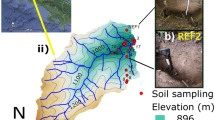Abstract
A new methodology used on a large scale is reported by which short-term (≤1 yr) marsh accretion rates were measured in saltwater and brackish marshes and compared to first-time measurements made in freshwater marshes. The stable rare-earth elements (REE) dysprosium and samarium were used for soil horizon markers that were collected by a cryogenic field coring method and detected by instrumental neutron activation analysis (INAA). Accumulation in saltwater marshes for 6 months was estimated to be 0.76±0.26 cm (n=11) and accumulation for 1 year was 1.29±0.49 cm (n=7). Accumulation in brackish marshes for 6 months was 0.51±0.34 cm (n=6) and for 1 year, 0.84±0.32 cm (n=10). These data from saline and brackish environments can be compared to first-time measurements of accumulation in a freshwater marsh of 1.53±0.66 cm (n=8) for 6-month accumulation and 2.97±0.92 cm (n=11) for 1-year accumulation. The cryogenic REE-INAA method for sampling and measuring 6-month and 1-year accretion is nonpolluting, does not alter natural marsh soil processes, and is effective in salt, brackish, and freshwater marshes. Additionally, the marker is essentially immobile, long lasting in the soil profile, and inexpensive to buy, apply, and sample. INAA analysis of the cores is expensive and time-consuming, yet the REE-INAA method yields accretion data, especially in freshwater habitats, that are obtainable in no other way. A comparison between short-term accretion and the presence or absence of man-made canals showed no statistically significant differences of accretion along transects from 0- to 50-m distance into brackish and saltwater marshes (no freshwater transects were established). Sediment depositions measured at 50 m into fresh, brackish, and saltwater marshes from natural or man-made waterways showed no statistically significant differences of accretion within each habitat over a 6-month or a 1-year time period.
Similar content being viewed by others
Literature Cited
Armentano, T. V., andG. M. Woodwell. 1975. Sedimentation rates in a Long Island marsh determined by210Pb dating.Limnol. Oceanogr 20:452–456.
Baumann, R. H. 1980. Mechanisms of maintaining marsh elevation in a subsiding environment. M.S. Thesis, Louisiana State University, Baton Rouge. 92 p.
Baumann, R. H., J. W. Day, Jr., andC. A. Miller. 1984. Mississippi deltaic wetland survival: Sedimentation versus coastal submergence.Science 224:1093–1095.
Cahoon, D. R.,andR. E. Turner. 1989. Accretion and canal impacts in a rapidly subsiding wetland. II: Feldpar marker horizon technique.Estuaries 12:260–268.
Casey, W. H., A. Guber, C. Bursey, andC. R. Olsen. 1988. Chemical controls on ecology in a coastal watland.EOS, 67: 1305: 1310–1311.
Covell, D. F. 1959. Determination of gamma-ray abundance directly from the total absorption peak.Anal. Chem. 31:1785–1790.
Cowardin, L. M., V. Carter, F. C. Golet, and E. T. Laroe. 1979. Classification of wetlands and deep water habitats of the United States, U.S. Fish Wildlife Service. Biological Service Program, FWS/OBS-79/31 103 p.
DeLaune, R. D., R. H. Bauman, andJ. G. Gosselink. 1983. Relationships among vertical accretion, coastal submergence and erosion in a Louisiana Gulf Coast marsh.J. Seb. Petrol. 53:147–157.
DeLaune, R. D., W. H. Patrick, Jr., andR. J. Ruresh. 1978. Sedimentation rates determined by137Cs dating in a rapidly accreting salt marsh.Nature 275:532–533.
DeLaune, R. D., J. S. Whitcomb, W. H. Patrick, Jr.J. H. Pardue, andR. S. Pezeshki. 1989. Accretion and canal impacts in a rapidly subsiding wetland: I.137Cs and210Pb techniques.Estuanes 12:247–259.
Faure, C. 1986. Principles of Isotope Geology. 2nd ed. Chapter 23 John Wiley & Sons, New York. 589 p.
Guinasso, Jr.,N. L., andD. R. Schink. 1975 Quantitative estimates of biological mixing rates in abyssal sediments.J. Geophys. Res. 80:3032–3043.
Knaus, R. M 1986. A cryogenic coring device for sampling loose unconsolidated sediments near the water-sediment interface.J. Sed. Petrol. 56:551–553.
Knaus, R. M., 1981. Double activation analysis, the simultaneous use of radiotracers and activable tracers in a stream microcosm.Environ. Sci. Technol. 15:809–812.
Knaus, R. M., andL. R. Curry. 1979. Double activation analysis: A new application of established techniques.Bull. Envioron. Contam. Toxicol. 21:388–391.
Knaus, R. M., andA. H. El-Fawaris. 1981. A biomonitor of trace heavy metals: Indium and dysprosium in red alder roots,Alnus rubra Bong.Env. Exp. Bot. 21:217–233.
Knaus, R. M., and D. L. van Gent. 1988. Marsh accretion, mineral sediment deposition, and organic matter accumulation: Rare earth stable tracer technique, Chap. 16, p. 277–297.In R. E. Turner and D. R. Cahoon (eds.), Causes of Wetland Loss in the Central Gulf of Mexico. Vol. II: Technical Narrative. Final Rep. submitted to the Minerals Management Service, Dept. of the Interior, New Orleans, Louisiana. OCS study/MMS 87-0120. 400 p.
Miller, K. M., andM. Heit. 1986. A time resolution methodology for assessing the quality of lake sediment cores that are dated by137Cs.Limnol Oceanogr. 31:1292–1300.
Olsen, C. R., I. L. Larsen, P. D. Lowry, N. H. Cutshall, J. F., Todd, G. T. Wong, andW. H. Casey. 1985. Atmospheric fluxes and marsh-soil inventories of7Be and210Pb.J. Geophys. Res. 90:10,487–10,495.
Richard, G. A. 1978. Seasonal and environmental variations in sediment accretion in a Long Island salt marsh.Estuaries 1:29–35.
Robbins, J. H., P. L. McCall, J. Berton Fisher, andJ. R. Krezoski. 1979. Effect of deposit feeders on migration of137Cs in Lake sediments.Earth Planet. Sci. Lett. 42:277–287.
Schaffner, L. C., R. J. Diaz, C. R. Olsen, andI. L. Larsen. 1987. Faunal characteristics and sediment accumulation processes in the James River Estuary, Virginia.Estuarine Coastal Shelf Sci. 25:211–226.
Simpson, H. J., C. R. Olsen, R. M. Tricer, andS. C. Williams. 1976. Man-made radionuclides and sedimentations in the Hudson River estuary.Science 194:179–183.
Steel, R. G. D., andJ. H. Torrie. 1980. Principles and Procedures of Statistics, a Biometrical Approach. 2nd ed. McGraw-Hill, New York. 633 p.
Stearns, L. A., andD. MacCreary. 1957. The case of the vanishing brick dust.Mosquito News 17:303–304.
Van Gent, D. L. 1988. Rare-earth soil horizon markers to determine short-term accretion in Louisiana marshes. M.S. Thesis, Nuclear Science Center, Louisiana State Univ. Baton Rouge. 229 p.
Author information
Authors and Affiliations
Rights and permissions
About this article
Cite this article
Knaus, R.M., Van Gent, D.L. Accretion and canal impacts in a rapidly subsiding wetland. III. A new soil horizon marker method for measuring recent accretion. Estuaries 12, 269–283 (1989). https://doi.org/10.2307/1351906
Received:
Accepted:
Issue Date:
DOI: https://doi.org/10.2307/1351906




